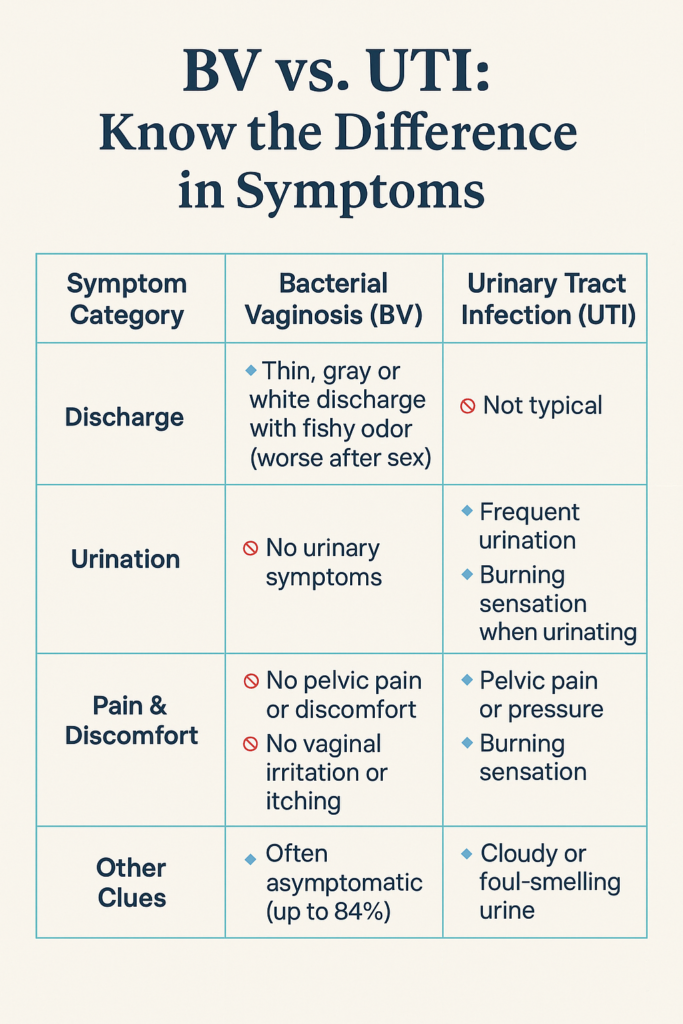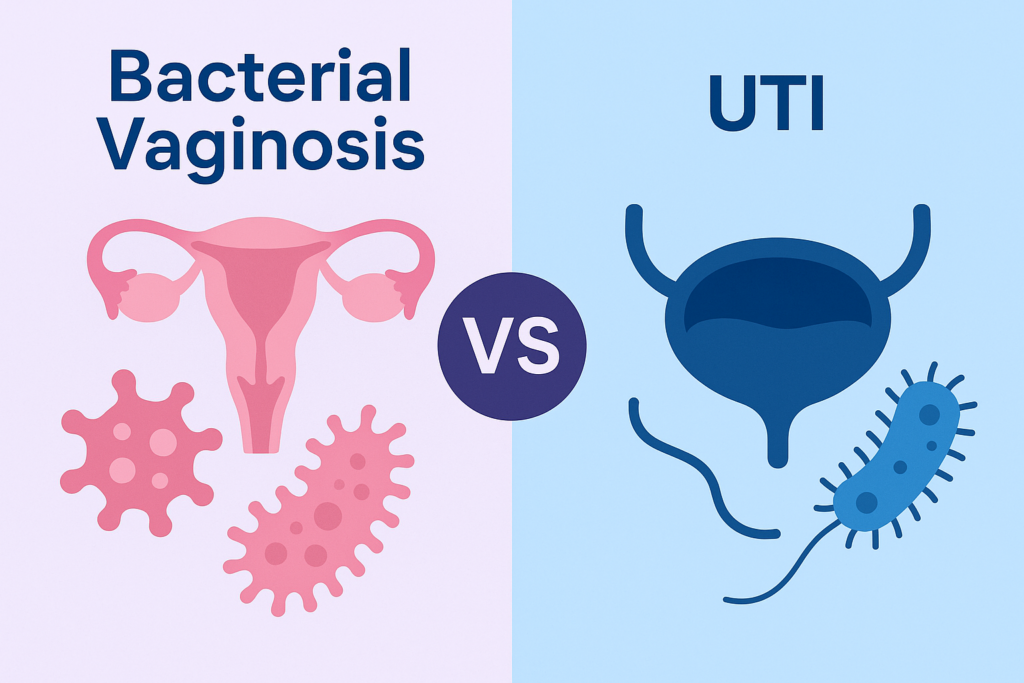Confused about the difference between bacterial vaginosis (BV) and urinary tract infections (UTI)? You’re not alone. This article breaks it down for you. Learn the differences in symptoms, causes and treatments so you know what you’re dealing with and how to get help.
Quick Facts
- Bacterial vaginosis (BV) is the most common vaginal infection in women 15-44, has a fishy odor, and produces abnormal discharge. UTI’s affect the urinary system and have symptoms of burning when you pee.
- Symptoms: BV has no irritation, just unusual discharge. UTI’s have urinary symptoms like frequent urination and pelvic pain.
- Both Urinary Tract Infections and BV need to be treated promptly to prevent complications; BV untreated can lead to reproductive health problems, UTI’s can lead to kidney infections.
What is Bacterial Vaginosis (BV)?
BV is the most common vaginal infection in women 15-44. It’s caused by an overgrowth of existing vaginal bacteria upsetting the natural balance in the vagina. Unlike other infections, BV is not contagious but is affected by activities like douching and unprotected sex which can upset the balance of vaginal bacteria.
The symptom of BV is an unusual vaginal discharge that has a fishy smell especially after sex. This discharge is thin and grayish white. Another indication is the decrease in beneficial Lactobacilli bacteria and the prevalence of harmful Gardnerella vaginalis bacteria in the vaginal region. BV doesn’t cause vaginal itching or irritation unlike other vaginal infections.
If left untreated BV can trigger recurrent infections and more complications.
What is a Urinary Tract Infection (UTI)?
Urinary tract infections (UTIs) are infections of the urinary system which can be in the lower tract (bladder infection) or upper tract (kidney infection). These can occur anywhere in the urinary system, including the urethra, bladder, ureters and kidneys. The most common cause of UTIs is the bacteria Escherichia coli (E. coli), but other bacteria can be the culprit.
Women are more prone to UTIs due to their shorter urethras which make it easier for bacteria to get to the bladder. This is especially true for women 25-29 years old as UTIs are more common in this age group.
Common UTI symptoms are burning sensation when urinating, strong and persistent urge to urinate, and cloudy or bloody urine.
Left untreated, UTIs can lead to other infections, so act fast!
Comparing Symptoms of BV and UTIs

Distinguishing between BV and UTIs can be challenging, but it’s crucial in understanding your ailment.
The main symptoms of bacterial vaginosis include abnormal vaginal discharge with a fishy odor, which can be particularly noticeable after intercourse. Interestingly, up to 84% of individuals with BV may not exhibit any symptoms, complicating the diagnosis process.
BV typically does not cause vaginal irritation or itching unlike other infections. BV typically presents with abnormal vaginal discharge, while UTIs are identified by urinary symptoms such as frequent urination and pelvic pain. Identifying BV symptoms is crucial for accurate diagnosis.
Differentiating between these conditions ensures appropriate treatment and avoids complications. Misdiagnosing BV as a UTI or vice versa can result in ineffective treatment, prolonging discomfort and increasing health risks. Recognizing the unique symptoms of each condition empowers individuals to seek the correct medical advice and treatment, leading to better health outcomes.
Causes and Risk Factors for BV and UTIs
Unlike their symptoms, BV and UTIs share similar causes and risk factors, as both BV and UTIs are linked to an imbalance of bacteria and poor hygiene practices.
For BV, activities that disrupt the normal vaginal flora (like douching) significantly elevate the risk. Additionally, individuals with multiple or new sexual partners are more likely to develop bacterial vaginosis. Good hygiene mitigates the risk of BV by balance of the vaginal microbiome.
Sexual activity significantly influences the risk of developing BV. Unprotected sex can introduce new bacteria into the vaginal area, increasing the likelihood of an imbalance. Pregnant women are also at a heightened risk for BV, which can lead to complications such as premature birth.
Common causes of UTIs include bacterial infections, sexual intercourse, and urinary tract abnormalities. The risk of developing a UTI increases in females. Certain types of birth control and having urinary tract abnormalities also increases risk. Interestingly, having BV may also increase the likelihood of developing a UTI, highlighting the interconnected nature of these conditions.
Diagnosing BV vs UTI
Accurate diagnosis of BV and UTIs ensures proper treatment and avoids complications. For bacterial vaginosis, healthcare providers typically analyze vaginal discharge samples and perform pH tests, which usually show a pH level over 4.5. This confirms the presence of BV and helps determine the appropriate course of treatment.
Diagnosing UTIs typically involves urine analysis and culture tests to identify the specific bacteria causing the infection. In some cases, imaging tests may be used to check for urinary tract abnormalities that trigger recurrent UTIs. Consulting healthcare providers ensures accurate diagnosis and appropriate treatment plans, especially since symptoms can be absent or overlap with other conditions.
Treatment Options for BV and UTIs
When it comes to treating bacterial vaginosis, effective options include antibiotics such as metronidazole, clindamycin, and tinidazole. Pelvic floor physical therapy (PFPT) offers a non-antibiotic approach, addressing underlying pelvic health issues that may contribute to recurrent BV. The main goal of BV treatment is restoring the balance of vaginal bacteria.
For UTIs, common antibiotics include trimethoprim-sulfamethoxazole, nitrofurantoin, and ciprofloxacin. The standard treatment for a UTI involves antibiotics aimed at eliminating the bacterial infection and alleviating symptoms.
Prompt treatment for both BV and UTIs prevents complications and ensures effective symptom relief. Understanding available treatment options empowers individuals to seek timely and appropriate medical care, aiding in quick recovery and preventing potential recurrences. As always, consult with your doctor before deciding to start any anti-biotic medical treatment; they will provide you the best treatment plan.
Preventing BV and UTIs
Prevention is always better than treatment. Maintaining good hygiene is a fundamental step in preventing these infections. Simple practices such as urinating shortly after intercourse can help lower the chances of developing infections. Changing out of wet clothing promptly is also important to prevent a moist environment that favors pathogen growth.
Wearing breathable, cotton underwear helps promote air circulation and reduce moisture buildup, thus aiding in the prevention of both BV and UTIs. Consulting with a healthcare provider can provide additional guidance on safe practices to manage and reduce the risk of these infections. Implementing these hygiene practices and safe sexual habits can significantly contribute to maintaining vaginal and urinary tract health.
Potential Complications of Untreated BV and UTIs
The potential complications of untreated BV and UTIs underscore the importance of timely medical intervention. Untreated BV can heighten the risk of sexually transmitted infections such as chlamydia and HIV. Long-standing BV may also lead to pelvic inflammatory disease, which can result in infertility. Additionally, BV can increase the likelihood of complications following gynecological procedures.
For pregnant individuals, untreated BV poses a greater risk of low birth weight and early labor. Infections like BV and UTIs during pregnancy can lead to complications for both mother and baby, such as premature birth and other neonatal health issues.
Untreated urinary tract infections can lead to serious complications, such as kidney infections that could cause sepsis. Therefore, seeking proper treatment for both BV and UTIs is crucial to prevent severe complications and ensure both maternal and fetal health.
Can You Have BV and a UTI at the Same Time?
Yes, it is possible to have bacterial vaginosis and a urinary tract infection at the same time. These conditions can coexist without one turning into the other, although having BV may increase the risk of developing a UTI.
Prompt treatment of both conditions is important to avoid complications and ensure effective symptom relief. Learning more about these diseases and understand they can be concurrent will aid you in treating them.
Importance of Consulting Healthcare Providers
Consulting a healthcare provider ensures proper diagnosis and treatment of both BV and UTIs. A correct diagnosis and treatment plan help avoid severe complications, such as pelvic inflammatory disease from BV or kidney infections from UTIs. Knowing what you have is always the first step in correct treatment. Inadequate or mistreatment for BV and UTIs can lead to antibiotic resistance and other side effects, making future infections harder to treat.
Common side effects of antibiotics for UTIs include nausea, vomiting, and diarrhea, so it’s essential to follow the healthcare provider’s instructions carefully. Regular consultations with healthcare providers can enhance the management of women’s health by providing tailored advice and monitoring for any recurrent issues.
Patients should discuss their concerns or potential risks with their healthcare provider before starting treatments like PFPT for BV or any new antibiotic regimen. All prescribed medications should be taken as directed, even if symptoms improve, to ensure full eradication of the infection and prevent recurrence.
Summary
Bacterial Vaginosis (BV) and Urinary Tract Infections (UTIs) are common conditions that affect many women, each with distinct symptoms, causes, and treatments. BV is characterized by a fishy-smelling vaginal discharge and is often caused by an imbalance of vaginal bacteria, while UTIs primarily affect the urinary system, causing symptoms like a burning sensation during urination and frequent urination. Understanding these differences is crucial for accurate diagnosis and effective treatment.
Preventive measures, including maintaining proper hygiene and seeking personalized advice from healthcare professionals, are crucial in managing and mitigating the risks associated with these infections. Prompt treatment is imperative to prevent severe complications such as pelvic inflammatory disease and kidney infections. By staying informed and proactive regarding their health, women can effectively manage these conditions and preserve their overall well-being.
FAQs
What is the main difference between BV and a UTI?
Bacterial Vaginosis (BV) primarily results in abnormal vaginal discharge with a fishy odor, whereas urinary tract infections (UTIs) typically cause urinary symptoms such as burning during urination and frequent urges to urinate.
What are the risk factors for developing BV?
Douching, having multiple or new sexual partners, and hygiene practices that disturb the vaginal microbiome are the primary risk factors of BV. Maintaining a balanced approach to both hygiene and sexual health can help mitigate these risks.
How are BV and UTIs diagnosed?
BV is diagnosed by analyzing vaginal discharge samples and conducting pH tests, whereas UTIs are identified through urine analysis and culture tests. Accurate diagnosis is crucial for effective treatment.
Why is it important to consult healthcare providers for BV and UTIs?
Delayed or mistreatment of either may result in further complications. Consulting healthcare providers for ensures you are obtaining an accurate diagnosis and effective treatment which will promote your general health, as well.
Sources:
CDC. https://www.cdc.gov/bacterial-vaginosis/about/index.html
Cleveland Clinic. https://my.clevelandclinic.org/health/diseases/3963-bacterial-vaginosis
